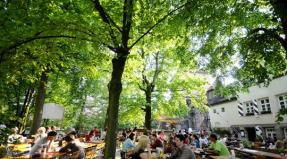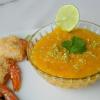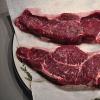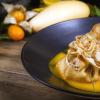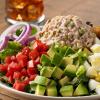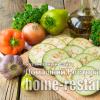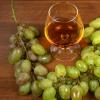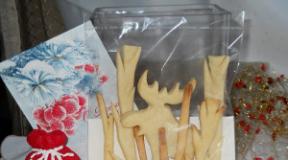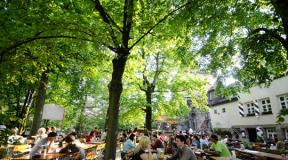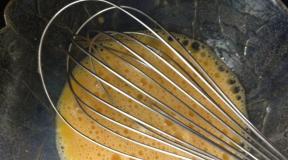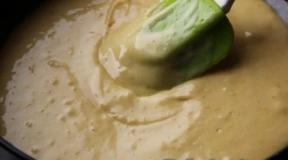A small textbook of simple food from the field of Bocuse. Paul Bocuse, French legend My best Paul Bocuse recipes read
History remembers the great chefs of the past. Antoine Carême and Károly Gundel forever inscribed their names on the pages of her invisible book, others disappeared forever. The new generation of chefs - , - have everything you can dream of, and only time will tell which of them will be remembered a hundred years from now. But among our contemporaries there are also those about whom we can absolutely say: they deserved their place in the pantheon during their lifetime. After all, chefs come and go, but gastronomy is eternal. It was to her that the classic of French cuisine Paul Bocuse dedicated his life.
Monsieur Bocuse was born in 1926 into a family of hereditary cooks, and from the very beginning it was clear what fate was in store for the boy who entered one of the restaurants in Lyon as an assistant cook. Five years before Paul was born, his grandfather, Joseph Bocuse, sold the family restaurant, and at the same time the right to use the Bocuse sign, which his grandson was able to return only many years later.
But more on that later.
After all, through the youth of Paul Bocuse, like other people of that era, the Second World War passed with a bloody flourish. It has now become fashionable to blame the French for how quickly they surrendered France and for the fact that most of them did not support the Resistance, feeling great under occupation.
One way or another, after the outbreak of the war, Paul Bocuse joined the army as a volunteer, fought and was seriously wounded in Alsace. Salvation came to the future great chef in the person of American doctors from a field hospital. “I always say that American blood flows in my veins, because the Americans gave me blood transfusions,” Bocuse admitted.

Bocuse’s main merit is the creation of “new cuisine”, which replaced the classic “cuisine classique” - pretentious, complex, high-calorie. Bocuse and his colleagues began to build their cuisine according to completely different principles, which were formulated by authoritative restaurant critics Henri Gault and Christian Milhaud:
- Refusal to overcomplicate cooking.
- Cooking times for fish, seafood, game birds, veal, green vegetables and pates are significantly reduced to preserve the natural flavour.
- Dishes are prepared from the freshest ingredients possible.
- Refusal of large menus in favor of shorter ones.
- Refusal to use strong marinades for meat and game.
- Avoid using heavy sauces thickened with flour, such as Spanish or bechamel, in favor of flavoring dishes with fresh herbs, quality butter, lemon juice and vinegar.
- Inspiration is drawn from regional dishes instead of classic cuisine.
- The use of new technologies and modern equipment: Bocuse even used (oh, horror!) microwave ovens.
- When preparing meals, chefs began to pay close attention to the dietary needs of guests.
- Adherents of “nouvelle cuisine” are extremely inventive and constantly create new combinations and combinations of products.
As we can see, almost everything that “new cuisine” is based on (except for very highly specialized aspects) has long become quite familiar to the mainstream - but in the middle of the 20th century, such an approach to restaurant cuisine, which sharply contrasted with home cuisine, was a novelty.

The term “nouvelle cuisine,” by the way, was also first used by Henri Gault, who described the dishes prepared by Bocuse and his colleagues for the first flight of the Concorde airliner in 1969. Six years later, in 1975, for a reception at the Elysee Palace, Bocuse first prepared truffle soup, which later became his signature dish: black truffle soup covered with a puff pastry cap, still served in Bocuse's restaurant under the name "Soup E.G.V." in honor of French President Giscard Valéry d'Estaing, who was present at the reception. Anyone can touch the gastronomic secrets of the Elysee Palace for just 80 euros.
The merit of Bocuse was not so much the creation of the concept of “new cuisine”, but its active dissemination. Many of his students, raised in the “nouvelle cuisine”, became famous chefs who introduced this tradition in their countries, and ““, created in 1987, has become the most prestigious award awarded annually to chefs from all over the world. Bocuse himself was also not spared all sorts of insignia - just mention the highest French award, the Order of the Legion of Honor. On March 30, 2011, the Culinary Institute of America awarded Paul Bocuse the title of Chef of the Century.

Mere mortals can touch the maestro’s creations in his restaurant L’Auberge du Pont de Collonges, which is more often called simply “Bocuse”: in 1966, Paul Bocuse finally bought the family brand, once sold by his grandfather. The restaurant, now a stronghold of French cuisine, was awarded 3 stars by Michelin in 1965, and since then it has not left the top of the gastronomic Olympus.
Many critics, however, argued that such a special attitude was a kind of nod to the merits of the great chef, not reflecting the real standard that the restaurant held - but who would dare to take the star away from Bocuse himself?.. Despite the high prices, Bocuse was recorded many days in advance. For those who cannot afford such an expensive pleasure, Bocuse opened a network of brasserie with more affordable prices in Lyon, which the maestro considered the gastronomic capital of France.
In old age it is difficult not to be a conservative, especially since Bocuse’s approach, once revolutionary, has long become a classic. The maestro was calm about new trends in cooking, believing that if the restaurant is open and full of guests, the chef is doing everything right, regardless of the cuisine he offers. However, about Ferran Adria, who is considered the creator of the modernist approach to cuisine, Bocuse said that he was just a cook.
And this, probably, lies the whole philosophy of the most titled chef of our time: in order to reach heights, you don’t need to be the creator of anything. It's enough to just be a cook.
On January 20, 2018, Paul Bocuse passed away - the great chef, who had been suffering from Parkinson's disease for many years, died in his restaurant.

On this occasion, the French Interior Minister, Gérard Collon, tweeted: “Monsieur Paul was France. Simplicity and generosity. Mastery and art of living. The pontiff of gastronomy has left us. May our chefs in Lyon and all over the world cherish the fruits of his passion for a long time to come.”
One of the most legendary chefs of the century is Paul Bocuse. Despite the fact that all his recipes are extremely simple and accessible even to people who are not very creative in the field of cooking, and the dishes are somewhat peasant-rich, all this certainly belongs to haute cuisine. The best recipes of Paul Bocuse, his biography and career are in our article.
Dynasty
Paul Bocuse, a fifth-generation chef, has been continuing the restaurant business since the time of his great-great-great-grandmother, who was not only a beauty, but also an extremely good cook. The family owned a mill and opened a tavern there in the mid-eighteenth century. Guests loved visiting this establishment; the food that was offered to boatmen, peasants who came with their grain to the mill, and residents of surrounding villages was hearty, simple and extremely tasty.
Over the course of the first hundred years, the tavern turned into a restaurant that suddenly found itself on the railway route from Paris to Marseille. The building was destroyed. But the family business had already become so strong that they were able to continue it on the Saon River, where the monks of Il-Barba previously lived. So the year 1921 came - a time of dramatic changes. Paul Bocuse was not yet born when his grandfather decided to sell not only the establishment, but also the name.
Legend
They said that my grandfather was prompted to take this step by jealousy. Grandma, like almost all the women in the family, was a beauty, and many visitors tried to court her. Grandfather did not like this at all. It is not known for certain what event happened in the restaurant, but the establishment was sold along with the family name. If the dynasty had been interrupted, it is unlikely that we would have known such a wonderful chef as Paul Bocuse.
However, culinary roots penetrated too deeply into the souls of this family, so Georges - the next generation - chose the same field. He gained culinary experience in the best restaurants in Lyon and opened his own. He knew very, very many things, but for some reason his son did not learn from him. He chose as his teacher another excellent cook, Claude Marais, whose roots in this profession were no less deep.

Education
Mare did not immediately admit the student to the stove and cooking itself. At first, he spent a long time purchasing food and checking its freshness very carefully. Subsequently, this became a distinctive feature of the activities led by Paul Bocuse: his dishes were always prepared from absolutely fresh ingredients. The war began, the aspiring cook signed up as a volunteer and went to the front. During the Battle of Alsace he was quite seriously wounded. He fought well, received the cross “For Military Merit” in 1944, and in 1945 the famous Parisian Victory Parade awaited him.
When I returned home I had to change my job. The famous Fernand Point became Paul’s teacher, but even here he cooked meals much less often than he tended to the garden, washed dishes, washed clothes, ironed them and milked the cows. However, he still learned some subtleties from Point. And now the golden collection of Paul Bocuse's recipes is distinguished by the presence of tiny vegetables and very light sauces.

Return
Until the age of thirty-five, the legendary cook gained experience. But then, when he returned to his father’s restaurant, he developed the business so well that a year later the establishment received In 1965, there were already three. This was the pinnacle of glory. And financial affairs improved so much that Paul Bocuse bought his grandfather’s restaurant along with the family name. Now there is a banquet hall where food is served in the same way as in the time of the family’s distant ancestors: the food is very simple, but extremely tasty.
Paul Bocuse was happy to bring the family name back to the business because it was even more than just a well-known brand. This is the pinnacle of what is called improvement, a kind of perfectionism. Naturally, the restaurant, which has returned its name, and is even decorated with Michelin stars, is intended for the most successful, richest and most famous people whom Paul Bocuse gathered at his place. Reviews of dishes made from exclusively fresh and purely local products, which, moreover, do not lose their natural taste during cooking, span the globe.

New kitchen
In 1975, the master was awarded the Order of the Legion of Honor, and his gratitude was so great that a new culinary masterpiece was born. Paul Bocuse, whose recipes are as simple as they are ingenious, delighted the world with a soup named after the President of France.
It is truly very difficult to be simple! The soupe aux truffles, which has become the hallmark of Paul Bocuse's haute cuisine, consists of the freshest black truffles, chicken fillet, celery and carrots, champignon mushroom caps, white vermouth and foie gras. And for some reason, chicken bouillon cubes... Served in a branded fireproof cup with a high layer of puff pastry, which is used to cover the broth before going into the oven. Paul Bocuse did not treat the President to anything at the Elysee Palace!

Professional and social activities
No less famous is another recipe, the one that was invented by the culinary specialist Brioche, and his followers improved it in every possible way. Just like other famous cuisines, Paul Bocuse’s recipe for brioche dough differs significantly from the classic one. And in 1987, the culinary specialist received an officer rank in the Legion of Honor and treated another president. At the same time, the Golden Bocuse competition was established, the award of which for a chef now means the same as an Oscar for an artist.
The life of the master became more and more eventful from year to year. He opened restaurants, wrote books, participated in shows and television programs, and even created a Culinary Institute. Travel is becoming increasingly important. In 2003, he even visited Moscow, where he presented the Paul Bocuse brand. A person knows how to both work and have fun.
Addictions
Paul Bocuse loves antique kitchen utensils, especially cast iron cookware. He prefers a gas stove, but the oven in it should be electric. It is clear that this is due to better control: heating and temperature are regulated much more precisely in an electric oven. Paul Bocuse never changed his credo throughout his life. From the field or from the sea - straight to the table. Everything is fresh. None of his dishes take time or labor to prepare. That's why the tastes don't mix. Dishes are flavored only with lemon, herbs, vinegar and butter. Ingredients are preferred not imported, but local. The menu in his restaurant is always very short.
His books have been translated into many languages. “My Best Recipes” and “The Bible” were published in Russian. Paul Bocuse would not recommend downloading them if he understood at least a little Russian. The translators and proofreaders treated their work, to put it mildly, negligently. In his books, many recipes are not simply missing sometimes one or the other ingredients, but, what’s most terrible, the numbers indicating the quantity of products are completely mixed up. Paul Bocuse would never recommend his books to Russian cooks, who from time to time even win a gold prize named after him. And even more so, it’s impossible Beginners can learn these books. What a pity!

Several recipes, translated in detail
The dishes invented by the master are tasty and quick to prepare; they rarely contain ingredients that are difficult to obtain. Pumpkin puree soup (surely many have grandmothers who make it in Russian, without stuffed eggs), clafoutis - a simple pie with berries, which in a rare home is not on the table almost every day in the summer season, catfish or other fish, baked in dough or fried in flour - how can these dishes be foreign in our country? They are international.
But baked pate is a dish more similar to French. The thinnest slices of ham, veal, lard and pork are skillfully placed in a special form lined with dough, filled with minced meat, diluted with cognac, supplied with aromatic herbs. It would be interesting not only to try, but also to cook. It should be noted that Paul Bocuse has his own vineyards in the famous Beaujolais. Therefore, wines and cognacs often accompany his culinary masterpieces. And the obligatory components of almost every one of his dishes are cream and butter. This includes veal with champignons and baked carp. Wine, cream, butter.

Potatoes with eggs
And yet, how close Paul Bocuse’s gastronomy is to Russian cuisine! Most dishes are prepared from ingredients that never leave our kitchen. - summer village breakfast in any Russian outback, before mowing, for example. Tasty, healthy, nutritious. Where is the French elegance here? Cooled jacket potatoes, eggs not from the refrigerator, but from a basket or straight from a chicken nest, lard rendered in a frying pan. There will be an omelette with cracklings.
Only our grandmothers and mothers do not drain pork fat from the frying pan and then fry potatoes in it. And Paul Bocuse will return the cracklings to the frying pan, pour the eggs scrambled with water over it all, bring it to readiness and serve it with white bread fried in butter. Perhaps, not all Russians eat bread with potatoes, but otherwise this dish, as a representative of haute French cuisine, will be quite liked in our cities and towns.
Recipe from Paul Bocuse's book "My Best Recipes", which he himself called a small textbook of simple food. The book was reprinted after 25 years. Mine is in Russian, 2013. Yesterday we prepared a three-course Sunday lunch based on it. It seems like nothing special, ordinary products, but somehow it turned out very good)). I tried not to violate the technology, I only reduced the quantities, because they were cooking for two. Quite quickly - the fish and mushrooms were baked in the oven, and on the stove I turned the apple pie.
Serves 2
- 200 g brown champignons
- 30 ml cream 20%
- 20 g oil drain
- 30 g cheddar
- 1 large egg yolk
- Salt, freshly ground black pepper, nutmeg
Melt the butter in a frying pan and cook the mushrooms, stirring with a wooden spoon, until all the liquid has evaporated, 15 minutes. It took me less time.
During this time, preheat the oven. In a salad bowl, mix the yolk with cream, salt, pepper, grate a little nutmeg.
Grease a baking dish with oil, lay out the mushrooms, pour over the sauce, sprinkle with grated cheese.
Bake for 10-15 minutes, serve hot in the pan you baked in.
Bocuse suggests for 4 servings - 750 g champignons, 3 egg yolks, 70 g butter, 100 ml cream, 60 g grated Gruyère cheese, salt, pepper, nutmeg.
Paul Bocuse's recipe from the book "My Best Recipes" is actually for sea bream, but the sea bass on the counter looked much more fun, so I made this substitution.
For two
- Seabass approximately 500 g
- 1 medium red onion
- 150 g beige champignons
- 150 g cherry tomatoes
- 2-3 sprigs of thyme and parsley
- small bay leaf
- 1/2 cup dry white French wine
- 2 tbsp olive oil
- Half a lemon
- Salt pepper
Preheat the oven to 180 degrees.
Clean and gut the fish, rinse in cold water and dry with a towel. Rub the outside and inside with olive oil, place the thyme, bay leaf and parsley inside, place in a baking dish of the appropriate size for the fish, pour a little olive oil on the bottom. Place tomatoes, onions, chopped mushrooms around, salt and pepper everything to taste, pour wine over it.
Place in a hot oven for 20 minutes, then turn off the oven and leave the dish in it for another 5-7 minutes.
Serve in the same pan in which you baked, garnish with lemon wedges.
White rice or steamed potatoes are served as a side dish.
In the original recipe for 4 people - 1 sea bream weighing 1 kg, 200 g champignons, 200 g tomatoes, half a glass of dry white wine, 50 g onions, 50 g shallots, 2 tbsp olive oil, thyme, parsley, bay leaf, salt, pepper, lemon.
I would like to add that in the plates you must not forget to pour the resulting sauce-broth over everything and that it is very, very tasty.

Serves 2
- 100 g flour
- 1 egg
- 60 g sugar
- 125 ml milk
- 1/4 tbsp growing oil
- 1/4 tsp salt
- 1/2 tsp vanilla sugar
- 2 apples
If there are any lumps, drain the dough through a colander. Leave for 3 hours.
Just before frying, peel and grate the apples using a regular grater. Add the remaining sugar to the apples and mix well into the dough.
Grease a frying pan with vegetable oil, heat it and pour in the dough, it will look like a thick pancake. Turn it over every 7 minutes, fry for a total of 30 minutes. Poke it in the middle with a knife to make sure no dough or apples stick to it.
Serve warm, with sugar and heavy cream, which you will place in a separate bowl.
Bocuse suggests for 4 people - 200 g flour, 2 eggs, 125 g sugar, 250 ml milk, 1/2 tsp salt, 1/2 tbsp peanut butter, flavoring additive to taste - tbsp cognac or orange blossom tincture or vanilla, 4 apples ranet.
My comments.
Since I was cooking half the norm, I took a frying pan with a diameter of 18 cm. The first time you need to turn it over, testing with a spatula, when you feel that it will turn over)), after about 7 minutes. After 2 minutes, I smoothed the edges with a spatula so that they were not beveled. I forgot to put the remaining sugar in the apples; I didn’t need to, as it turned out.
Bake for 40 minutes, turning every 5 minutes. I didn't add any more oil.
The result is not a pancake, not a pancake, but a pie, very golden brown, quite dense, slightly moist from the apples and completely baked. Tasty! Very.

A simple homemade recipe. It has taken root in my kitchen. Minimum ingredients and effort. But the sauce turns out to be anything but banal. During the process, almost all of the vinegar evaporates, leaving the sauce with a pleasant sourness. The recipe calls for a whole chicken, but I think it's better to use just the thighs.
for 4 servings:
- 4 tbsp. butter
- 1 tbsp. olive oil
- 4 cloves garlic, DO NOT peel
- 1 chicken (approx. 1.7 kg) cut into 10 pieces
- freshly ground black pepper
- 1/2 cup rice vinegar
- 2 medium tomatoes, peeled, seeds removed and cut into 1 cm cubes
- 2 tbsp. chopped parsley
Add garlic.
Season the chicken with salt and pepper and fry on all sides over medium heat until golden brown, about 8 minutes.
Add vinegar and tomatoes. Bring to a boil, reduce heat and cook at a low simmer until the chicken is cooked through, about 15 minutes. Transfer the chicken to another bowl and cover.
Boil the sauce for 4 minutes until thickened. Remove from heat.
Squeeze the garlic, mash and mix with the sauce. Add remaining 2 tbsp. butter and parsley. Add salt and pepper to taste.
Pour the sauce over the chicken and serve.

Original recipe from the book “My best”. I used other types of meat and did not add nuts.
- 200 g veal
- 200 g pork tenderloin
- 100 g fat
- 50 g ham
- 1 egg
- 2 yolks
- 1 large shallot
- 1 tbsp cognac
- 2 slices white bread
- 1 tbsp flour
- Pepper
- Puff pastry briquette
Roll out a third of the dough and cut out a disc. Place the dough on parchment paper.
Place the minced meat tightly into a springform ring placed on top of the dough. Cover this with the rolled out reserved dough. Press the pie around the perimeter. Make a hole in the middle. Brush everything with yolk glaze. Decorate with cut out dough shapes. Roll into a ball and place on top of the pie hole for ventilation.
Bake for 50 minutes at 350 F.

For the test
- 250 g flour
- 150 g butter
- 75 g powdered sugar
- 1 egg
- 3 lemons (juice and zest)
- 100 g butter
- 125 g powdered sugar
- 3 eggs
- 2 tbsp. spoons of cream
The recommended shape is round with a diameter of 28 cm.
But I couldn’t be happier with the one I bought in Finland this winter) Now I bake all my tarts only in it.
That's why I have some dough left. And for the cream I took 2/3 of the stated ingredients.
Roll out the dough with a rolling pin. Thickness about 6 mm.
Place in the pan, trim the edges, and prick the dough with a fork. Additionally, you can add beans, after covering the dough with parchment.
Bake in an oven preheated to 180 g for 15 minutes.
Wash the lemons, grate the zest on a fine grater, and squeeze out the juice.
Mix softened butter with sugar, cream, eggs, mix thoroughly. Then add zest and juice and mix.
Remove the sand base from the oven and remove the weight. Reduce oven heat to 120 degrees. Pour the cream into the base and place in the oven for 30 minutes.
Cool. Place in the refrigerator for 3 hours.
Decorate as desired. There is no decoration in the book. And I put raspberries. Otherwise it turned out very faded.
Great with tea and coffee. But for dessert we had Solaris wine from the Nesterov Winery (Remember I wrote about them when talking about my trip to the Krasnodar Territory?). Duchess and propolis in the aroma (a hint of creaminess in the taste) perfectly complemented the lemon pastry, and the pastry added sophistication to the wine.
Recipe from the book “Paul Bocuse French Cuisine” 1977 edition.
- 110 g butter
- 1 cup flour
- 1/2 cup sugar
- 3 eggs (separate whites from yolks)
- 2 tbsp vanilla sugar

For this tart I made the pâte sucrée dough according to Paul Bocuse's recipe, everything else is the same as always. Favorite spring tart.
- 250 g flour
- 100 g cold butter
- a pinch of salt
- 125 g sugar
- 1.5 eggs (I have 1 egg and 1 yolk)
- 1 tsp orange color
- 4 large rhubarb stalks
- 150 g sugar
- 1 tbsp. starch
- 1+1 tbsp. Sahara
- powdered sugar for serving
After 15 minutes, I took the dough out of the refrigerator, quickly rolled it into a flat cake about 0.5 cm thick, lined a tart pan with a diameter of about 28 cm and put it back in the refrigerator for an hour.
Peeled the rhubarb, cut it into cubes with a side of about 1 cm, covered it with sugar, put it in a colander, and put it in a bowl so that the juice flows into it.
It would be nice to pre-bake the basket blindly, without filling, but I didn’t do that.
I sprinkled the bottom of the basket with sugar and starch, laid out the rhubarb, sprinkled it with sugar, baked it in an oven preheated to 190°C until the sides were beautifully dark golden brown (about 45 minutes).
If the tart is cooled before serving, the juice will congeal. But we always eat rhubarb tarts hot, and they are very tasty.

This is how I don’t like to fry pancakes, but according to this recipe, not a single pancake was lumpy. They turn over without problems.
For about 15 pancakes:
- Butter - 50 g
- Flour - 250 g
- Granulated sugar - 1 tbsp.
- Salt - 1 pinch
- Egg - 3 pcs
- Milk - 500 ml
- Vegetable oil - for frying
2) In a deep dish, mix flour, sugar, salt and eggs. Add milk and mix gently with a whisk.
3) Add melted butter, stir, cover the dish with a towel and leave the dough on the table for 1 hour.
4) Heat a frying pan, grease with vegetable oil and bake pancakes.
5) Place the finished pancakes on a plate and cover with film so that the edges do not dry out.
Notes: I always add 1 tbsp to the dough. Roma I add oil to the pan only when baking the first pancake, and then do not add any more.
The pancakes are not sweet, so you can safely serve them with jam, chocolate spread, condensed milk, and so on.

Serves 2
- 125 g flour
- 1 egg
- half a teaspoon of powdered sugar + for sprinkling to taste
- 50g butter
- zest of half a lemon
- 1.5 g baking powder
- 1 tsp rum
- oil for frying (I needed about 1 cup, I fried 7-8 pieces in a small saucepan)
Finely grate the lemon zest. Mix flour, powdered sugar and baking powder in a bowl, add egg, zest, rum, butter. Use your fingertips to knead the dough until it becomes soft.
Roll out the dough thinly on a cutting board sprinkled with flour, cut into triangles or squares, pierce them in the middle so that the donuts puff up better when deep-fried. I used a cocktail straw for the holes, cut them into squares with about 5 cm sides, there is no photo in the book.
Heat the oil for deep frying; it will be ready when a small piece thrown into it quickly turns golden. Then start putting pieces of dough in small portions into the hot oil. When they rise and become golden brown, place them on a paper towel. Make sure that the oil does not overheat too much.
Sprinkle sugar or powdered sugar on top and serve.
According to the book for 8 people - 500g sifted flour, 200g drained butter, zest of 1 lemon, 4 eggs, 1 pinch of powdered sugar, 1/2 packet of baking powder, 1 tbsp of rum, 1 liter of peanut butter, sugar for glazing
Delicious, small portion prepared very quickly.

Mussel soup from cookginy
- 4 quarts mussels
- 1 bottle of white wine (Chardonnay)
- 3 shallots
- 3 1/2 tbsp chopped parsley
- 7 tbsp butter
- 1 1/4 cups olive oil
- 2/3 pound onions, finely chopped
- 2/3 pound leeks, sliced
- 6 1/2 pounds fresh fish
- 3 pounds tomatoes, chopped, seeds removed
- 3 1/2 tbsp fennel, chopped
- 2 cloves garlic
- 1/2 bay leaf
- 1 sprig thyme
- Saffron
- Salt and pepper
- 1 1/2 cups cream
- Crackers
- Grated cheese
Heat olive oil in a separate pan, add onions and leeks. Cook for about 5 minutes, stirring.
Add 4 quarts water, remaining wine and mussel juice; add fish, tomatoes, spices. Cook for 40 minutes.
Pass the soup through a sieve. Wipe everything to extract the juices. I removed the solid seasonings and put everything through a blender until it became a very fine paste.
I heated everything up and added cream and mussels removed from the shells at the last moment. I kept it on the stove for about 2 minutes.
Served with crackers and grated cheese.

Pea soup from rivka_ch
- 350 g split peas
- 1.5 liters of water
- 5 small carrots
- 1 “bouquet” of celery (do this for me, otherwise I can’t)
- 2 leeks
- 5 cloves garlic
- 1 slice of smoked loin type meat
- 1 chopped onion
- 1 tbsp. olive oil
- thyme, salt, bay leaf and black pepper to taste
Simmer leeks, onions, garlic and smoked meat in olive oil. Add carrots and celery, add water. Season and cook for 1.5 hours. Get out the bay leaf! Grind roughly with a mixer.

“There is nothing mysterious or magical in my recipes, just follow them.” This is how Paul Bocuse addresses his readers in the preface of his book “My Best Recipes.” It was first published in France more than a quarter of a century ago, then several years ago it was republished and, finally, this year it appeared in Russian translation by the Astrel publishing house.
According to the author, of the many books he wrote, this was the greatest success. And it's not hard to see why. Bocuse himself calls this work “a little textbook of simple food.” When the most famous chef of the 20th century gives such simple everyday recipes, it can't help but be a success. Unlike Bocuse's flagship restaurant l'Auberge du Pont de Collonges, which is difficult for the average person to get into - you have to make an appointment many months in advance, and the prices are very high - Bocuse's cuisine from this cookbook is more than accessible.

Bocuse is considered the founder of the “new” French cuisine. The term nouvelle cuisine was supposedly first applied to the dishes that Bocuse and several other French chefs prepared for the first flight of the Concorde supersonic passenger plane in 1969.
At the time, this cooking created a sensation due to its simplicity compared to the complex classical cuisine of France. After more than four decades, it is obvious that Bocuse’s cuisine is a true French classic, perhaps only freed from the excesses of previous eras.
In this sense, the word “textbook” that Paul Bocuse uses in relation to his book seems quite appropriate. Because the main thing in good cuisine is the technique of preparing dishes and rigor in relation to the choice of products. Otherwise, it doesn't matter whether you cook Chinese or Italian: the French school of cooking was and remains the best in the world. 
The simplicity that the 86-year-old French chef calls for is the wisdom of a chef who has seen everything, tried everything and trained generations of famous students. Several years ago I had the opportunity to attend a Bocuse master class in Moscow. Over the years I have also met some of the chefs in the Rhône-Alpes region where Bocuse works. The Troisgros brothers are all people with their own style and their own ideas about haute cuisine. But, watching how they cook, it is impossible not to be amazed at the precision of their movements and masterful command of food processing techniques. This is the same French school.
Bocuse shares some of his secrets in the book. He, for example, confesses his love for a cast-iron pan, the kind used by French peasant women at the time when he himself began to cook (in Lyon they say that the generation of great Lyon cooks inherited techniques and recipes from their mothers). He also writes that he prefers a gas stove with an electric oven. When I was choosing a stove for my dacha, I mistakenly ordered exactly this one (I wanted one with a gas oven). Now you can flatter yourself that this was Bocuse’s choice.

Eggs have a special place in French cuisine. Ancient cookbooks mention 543 ways to cook eggs. The French prepared them in Burgundian, Huguenot, Jesuit, Périgord, Regency, in rose water, in Provençal oil, with herbs, tarragon, basil, white partridge and poulard meat, in the form of fried eggs, with crayfish, truffles, sour grape juice, red tape, etc.
Famous Lyon chef Paul Bocuse collected several dozen popular recipes.
« Eggs in the kitchen play the same role as prepositions in speech, in other words, they are so necessary needed that without them the most skilled cook would give up his craft. No wonder they themselves churchmen, who know a lot about good food, softened in relation to eggs strict laws of fasting and allowed them to be used right up to Good Friday. It won't thicken without eggs no sauce, it won't happen no meatless stew. Egg - kind intermediary, extending his hand to different parties in order to bring everyone closer, everyone combine. There are eggs in pouch, eggs fried, eggs lemon- in a word, there are so many eggs in the world! Eggs are one of the most generous gifts, which all-good providence has presented to the human appetite,” wrote 19th-century French cook and gourmet Grimaud de la Reniere.
EGGS BEAUJOLAIIS

Ingredients for 4 persons
8
eggs
2
medium bulbs
1
clove of garlic
750 ml Beaujolais wines
1 tsp. coarse salt
5
peppercorns
parsley
bouquet garni:
1
celery sprig
1
leek
1
sprig of thyme
1/4
bay leaf

For leison
30 g butter
2 tbsp. l. flour
Cooking steps
Peel the onions and garlic, peel and wash the celery and leeks, cut the celery into 4 pieces. Prepare a bouquet garni.
Heat the oil in a heavy-bottomed stainless steel pan. When the oil is very hot, fry the onions in it until white, pour in the wine, add the bouquet garni, garlic crushed with a fork, salt and pepper. Cook over very low heat (so that the liquid bubbles slightly) for about 20 minutes, once it begins to boil.
During this time, prepare the lezon: soften the butter, kneading it with your fingers, and mix it with flour so that you get a homogeneous dough, set it aside. When the wine has finished cooking, remove the bouquet garni, remove the pan from the heat and pass the contents through a very fine sieve. Leave the onions aside.
Reheat the wine and bring it to just the beginning of a boil. Now break the eggs one at a time into a separate cup and cook the eggs in the bag by carefully pouring them from the cup onto the surface of the wine. It takes 4 minutes to get the egg into the bag.
When the eggs are cooked, remove them with a slotted spoon, place them on a hot plate and cover with a lid or napkin. After you complete this operation, put butter and flour into the wine, which is simmering gently, dividing the resulting lump into small cubes. Stir with a wooden spoon and check if there is enough salt and pepper.
When the sauce thickens, add eggs and serve this dish very hot. You can serve it with croutons with butter and rub them with garlic. When serving, sprinkle with finely chopped parsley.
EGGS A LA TRIP

Ingredients for 6 persons
500 g onions
100 g butter
40 g flour
800 ml chicken broth or milk
9
eggs
1
a pinch of fresh grated nutmeg
salt and pepper - to taste
Cooking steps
Peel the onions, cut each onion in half, and then cut each half into thin half rings.
Blanch in hot water for 5 minutes, then let the water drain.
Place the onions in a large saucepan and evaporate any excess moisture, then add the butter and brown, stirring the onions occasionally with a wooden spoon.
When the onion reaches the desired shade, add flour and mix everything again. Stirring gradually, add chicken broth or milk. Season with salt, pepper, grated nutmeg.
Simmer over low heat for 20 minutes, stirring constantly.
Hard boil the eggs. Peel and slice using an egg slicer or a small mandolin.
Place half of the onion mixture in a deep dish. Place chopped eggs on top. Then layer the remaining onion mixture on top.
EGGS “MIMOSA”

Ingredients
4
eggs
mayonnaise sauce
2
large ripe tomatoes
a few green onions
1
small head of lettuce
100 g black olives
lemon
Cooking steps
Boil the eggs hard. Prepare mayonnaise sauce. Remove all components for preparing mayonnaise from the refrigerator approximately 1.5 hours before starting its preparation. Wash the tomatoes, remove the stems, wipe and cut crosswise and in half. Season with salt and set aside.
Wash and dry the green onions, chop them finely using scissors. Wash the lettuce thoroughly and dry it (without removing the veins), arrange the leaves along the edges of the serving dish so that they form a kind of whisk, and in the center place 4 lettuce leaves in the form of a nest in which you will place 4 tomato halves. When the eggs are cooked and cool, peel them and cut them in half lengthwise.
Remove the yolk without damaging the white. Set three halves of the yolks aside, crush the remaining 5 with a fork and mix with green onions, and then with mayonnaise, which must be added by spoon to form a homogeneous paste. Fill the egg whites with this paste, then place them on each tomato half, garnish with black olives, which can be pitted or pitted. Take a medium-hole egg slicer, crush the remaining yolks and sprinkle on top of the dish for decoration. Serve with the remaining mayonnaise, lemon or, if desired, tuna in oil.
From the book: The Golden Collection of Recipes by Paul Bocuse. M.: AST: Kladez, 2014.
2016-07-14T07:40:05+00:00 adminInteresting Factsculinary encyclopediaEggs have a special place in French cuisine. Ancient cookbooks mention 543 ways to cook eggs. The French prepared them in Burgundian, Huguenot, Jesuit, Périgord, Regency, in rose water, in Provençal oil, with herbs, tarragon, basil, white partridge and poulard meat, in the form of fried eggs, with crayfish, truffles, sour grape juice, red tape...
[email protected] Administrator Feast-onlineRelated Categorized Posts

After cooking, you will get 8-10 servings Cooking time: 1 hour 40 minutes Jamie's colleagues know what to cook with beets - this is a casserole, carpaccio and salad. What to cook from beets?...

After cooking you will get 4 servings Cooking time: 30 minutes Recipes with beets are loved in many cuisines. They are so numerous that it is often difficult to choose a recipe... Find out more today...


